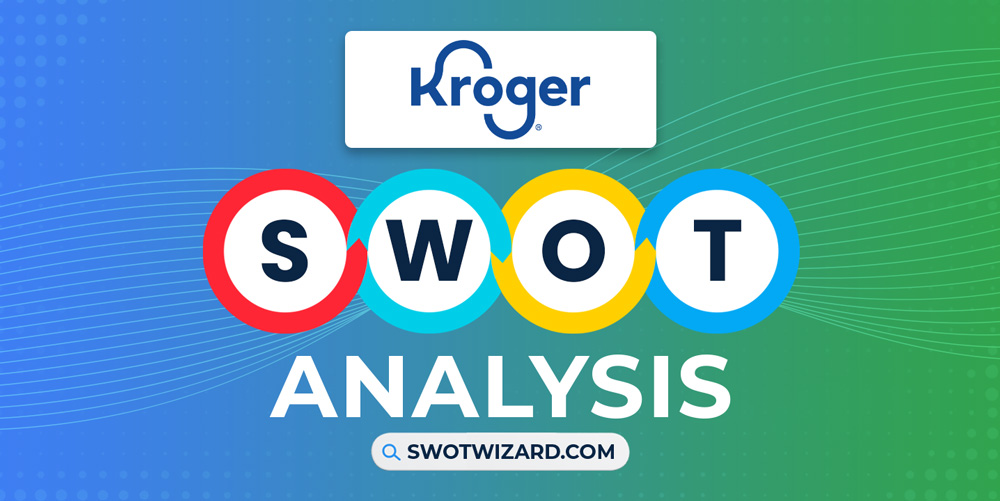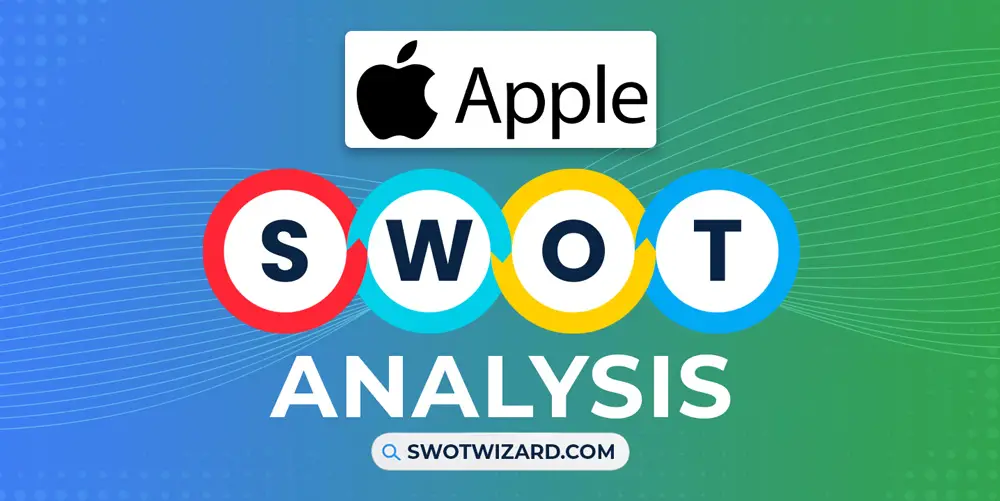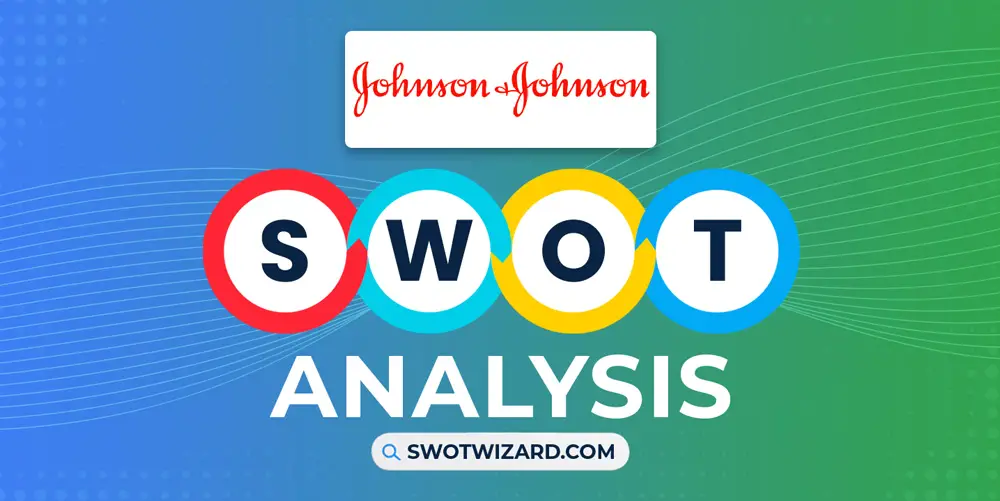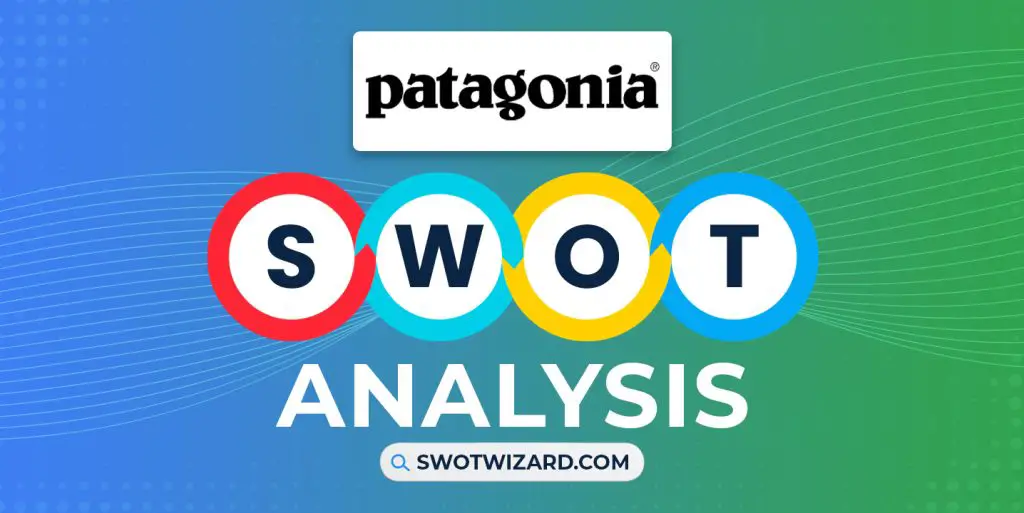Kroger holds the second-largest position in the grocery industry in the USA. The company is known for offering competitive pricing on its products, loyalty program, and digital efficiency. As the market is getting more competitive, the company is struggling with many challenges and holding its position with its strengths, and we will learn more in this Kroger swot analysis.
Kroger: Company Overview
| Company | The Kroger Company |
| Industry | Retail |
| Founded | 1883 |
| Founder | Bernard Kroger |
| CEO & Chairman | Rodney McMullen |
| Headquarter | Cincinnati, Ohio, U.S. |
| No. of Employees | 465,000+ |
| Annual Revenue | $137.888 billion (FY 2022) |
| Website | kroger.com |
The year was 1883 when Bernard Kroger opened a small grocery shop in Cincinnati, Ohio. From there, the company started as a small grocery store on Pearl Street and has since grown to become one of the largest supermarket chains in the United States.
With over 2,700 supermarkets and multi-department stores in 35 states, Kroger serves millions of customers daily. Kroger employs over 450K associates, making it one of the largest employers in the retail sector.
As for the financial parts, the company has reported total revenue of $148.3B in 2022.
Product & Services of Kroger
City Market | Gerbes | Baker’s | Dillons | Foods Co | Fred Meyer | Food 4 Less | Simple Truth | Fry’s
Kroger Competitors
Target | Walmart | Amazon | Costco | Dollar General | Rite Aid | Publix | Sprouts Farmers Markets | Albertsons
Did You Know?
Kroger has a popular customer loyalty program called Kroger Plus Card. Customers can earn fuel points, access digital coupons, and receive personalized offers based on shopping preferences.
Strengths – Kroger SWOT Analysis
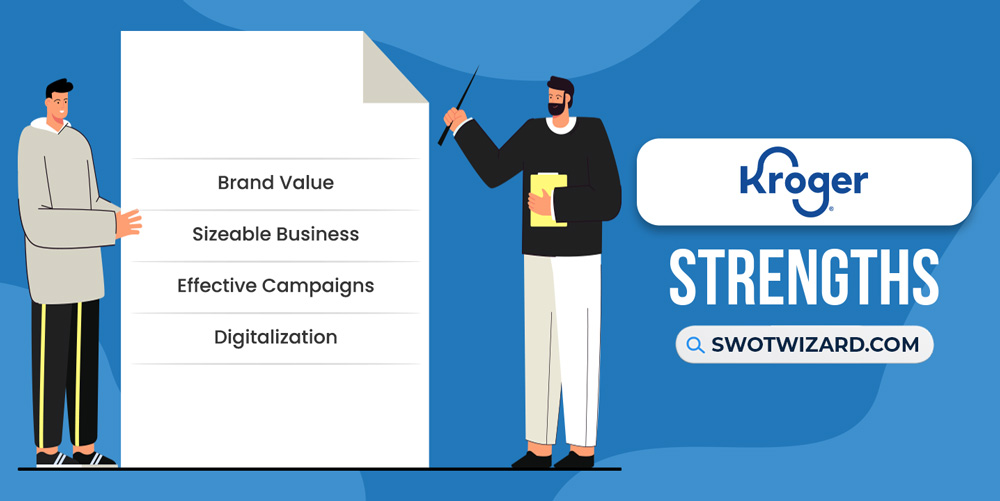
Brand Value: The company’s reputation for quality products, competitive pricing, and customer service has earned the trust of millions of consumers. As a result, Kroger has established a strong brand presence in the US grocery market and ranked 24th in Fortune 500, with an estimated brand value of $84.61B in 2022.
Sizeable Business: With over 2,719 supermarkets and multi-department stores across 35 states in the USA, Kroger operates on a large scale, giving it a significant 11.8% market share and economies of scale. It has helped the company to reach a broad customer base and leverage its purchasing power to negotiate favorable terms with suppliers.
Effective Campaigns: By effectively communicating its value proposition through advertising, Kroger has attracted and retained customers. Their “Fresh for Everyone” campaign emphasizes their commitment to providing fresh, affordable, and diverse food options for all customers and resonates with consumers.
Digitalization: The company’s online platform, including the website and mobile app, enables customers to conveniently order groceries for delivery or pickup. Besides, the company’s data-driven approach allows them to personalize offers and recommendations, enhancing the overall customer experience.
Weaknesses – Kroger SWOT Analysis
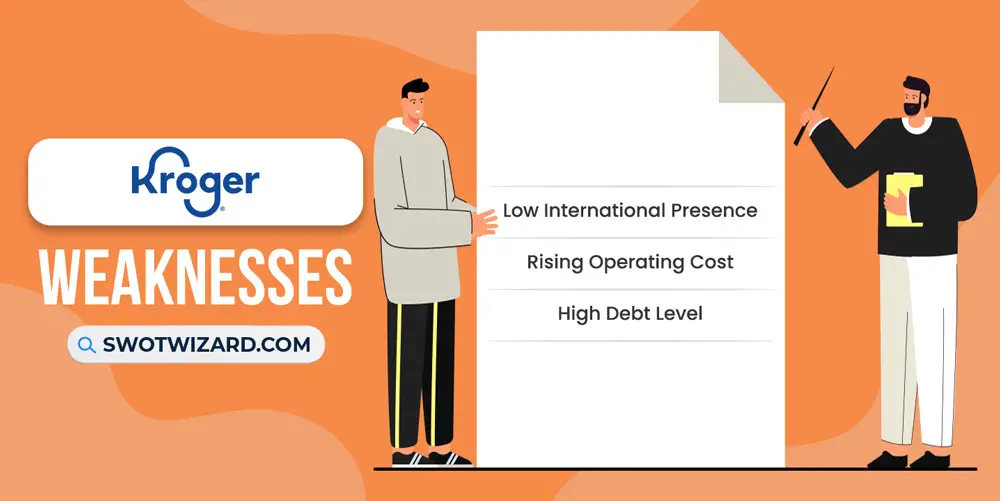
Low International Presence: Kroger’s operations are primarily concentrated in the United States, as there are no stores in any other country, thus limiting its exposure to international markets. As a result, the lack of global diversification makes the company vulnerable to economic fluctuations and regulatory changes specific to the US market.
Rising Operating Cost: The company operates in a labor-intensive industry, and as the minimum wage increases and healthcare costs continue to rise, it pressures Kroger’s profitability. The total operating expenses have risen by over $50B in the last ten years for various reasons.
High Debt Level: High debt levels can limit the company’s flexibility in pursuing strategic investments, acquisitions, or capital expenditure projects, potentially impacting growth prospects. According to data, Kroger’s long-term debt stood at $12.809B in 2022, which can create financial constraints and increase interest expenses.
Opportunities – Kroger SWOT Analysis

Market Expansion: As the company has no international presence, Kroger can expand its market by entering new geographical areas. They can open new stores or acquire regional grocery chains to access untapped markets.
Product Line Diversification: Demand for organic, natural, and specialty foods grows by 12% annually. By expanding its selection of these products, Kroger can attract health-conscious consumers and differentiate itself from competitors. That way, the company can explore diversifying its product offerings to cater to changing consumer preferences and capture new market segments.
Tech Adaptation: Technology presents opportunities for Kroger to enhance operational efficiency and customer experience. Investing in robots & automation, artificial intelligence, and data analytics can optimize supply chain management, inventory control, and personalized marketing efforts.
Strategic Partnerships: Kroger can expand into new segments or access innovative technologies by acquiring complementary businesses or entering strategic partnerships. As a part of the process, the company is using various supply partnership opportunities to efficiently the process, and in the last year, they acquired Albertsons for $24.6B.
Threats – Kroger SWOT Analysis
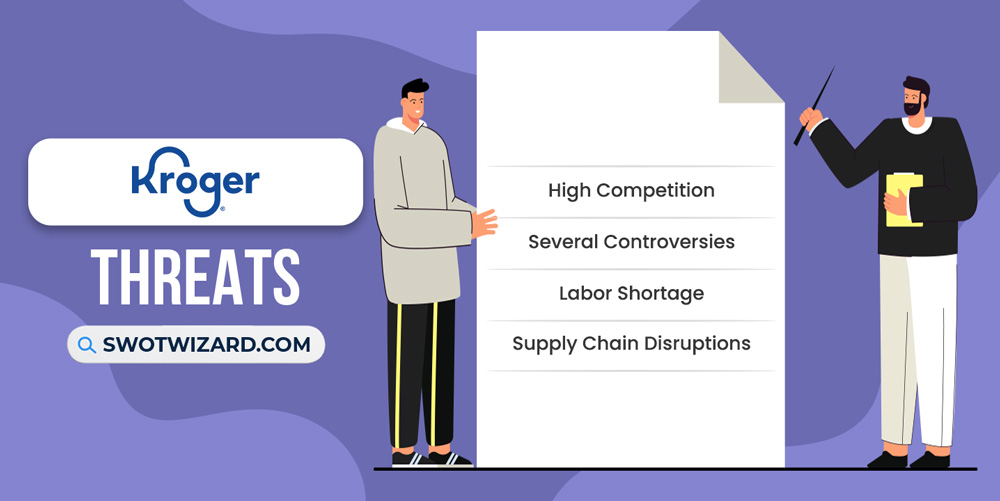
High Competition: The supermarket industry is already very competitive, and Kroger is facing intense competition from other supermarket chains, discount stores, online retailers, and even non-traditional players entering the grocery market. As a result, the company has been losing market share in the past couple of years, and it’s not improving.
Several Controversies: From issues related to labor practices, employee compensation, and product recalls the company has faced various controversies. A couple of years ago, Kroger faced backlash over accusations of racial discrimination and unfair treatment of employees, which led to negative publicity and potential customer boycotts. As a result, they had to pay a large amount to settle that down, and recently, they are facing four class action lawsuits.
Labor Shortage: The labor shortage in the retail sector poses a significant challenge for Kroger in terms of hiring and retaining qualified staff. As a result, the company has been constantly facing increased labor costs and difficulty maintaining adequate staffing levels. In 2021, there was a 10K labor shortage alone, and in 2023, that didn’t resolve yet.
Supply Chain Disruptions: Kroger relies on a complex supply chain to ensure the availability of products in its stores. But, several SCM disruptions have been happening, and the company has been facing challenges in maintaining adequate stock levels and meeting customer demands.
[Bonus Infographic] SWOT Analysis of Kroger
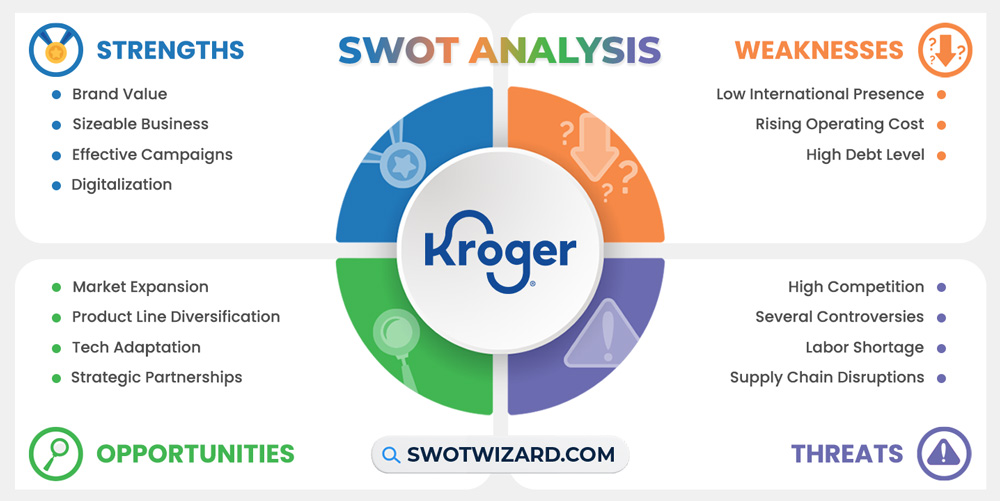
Recommendations for Kroger
The market is tough, and it’s getting tougher with increased competition and various reasons, and Krager should do a few things to grow and stay in the long run. Here are some recommendations for them.
- The company should explore opportunities for international expansion to tap into new markets and diversify revenue streams.
- There are options for expanding product offerings to include more organic, specialty, and locally sourced options to cater to changing consumer preferences.
- Invest in advanced technologies to enhance operational efficiency, personalize customer experiences, and optimize supply chain management.
- Form strategic partnerships with local food producers, farmers, and small businesses to promote community engagement, support local economies, and offer unique products.
Frequently Asked Questions (FAQs)
Is Kroger a Big Company?
Yes, Kroger is a big company.
How Many Krogers are in The US?
There are 2,720 Krogers in the US.
Final Words on Kroger SWOT Analysis
Kroger possesses strong brand value and a sizable business presence in the US grocery market. However, it faces threats from high competition, controversies, labor shortages, and supply chain disruptions. To maintain its position and drive future growth, Kroger should consider expanding internationally, diversifying its product line, embracing technology, forging strategic partnerships, and exploring acquisition opportunities. By addressing these challenges and capitalizing on opportunities, Kroger can continue to navigate the evolving retail landscape and meet the changing needs of its customers.
References
- Wikipedia contributors. (n.d.). Kroger. Wikipedia.
- Repko, M. (2021, November 4). Here’s how Kroger is using robots to get groceries to customers’ doors. CNBC.
- Bigora, P. (2023, February 6). Kroger to expand supply partnership with indoor farming company. Grocery Dive.
- Repko, M. (2022, October 14). Kroger agrees to buy rival grocery company Albertsons for $24.6 billion. CNBC.
- Amid labor shortage Kroger looks to hire 10,000. (2021, June 9). The Produce News.

